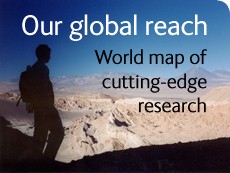Nature on film
Secrets of the Stegosaurus skeleton
Watch the world's most complete Stegosaurus skeleton arrive at the Museum. Follow its first few months behind the scenes as it underwent rigorous scientific examination.
Watch our films in HD on YouTube
More than 300 scientists work at the Natural History Museum carrying out vital research into the natural world. Take a look at some of their work in this film archive.
-

Clues to Britain’s own ancient Atlantis
At half a million years old, a bounty of fossils found on a UK beach could point scientists to the oldest undersea archaeological site in the world.
-

Pictures worth a thousand words
Museum scientist Sandy Knapp and curator Andrea Hart discuss the value and evolution of scientific imaging, and Molly Clery has a porpoise foetus CT scanned.
-

Hairy anglerfish's last meal revealed
Watch the video of a 3D scan revealing the contents of the mysterious anglerfish's huge stomach, something that has puzzled scientists for years.
-

Discovering the earliest pioneers
Follow the research into exciting new traces of the earliest known humans in Britain.
-

Fungi: undervalued jewels of the urban jungle
Museum fungi expert Mark Spencer reveals striking examples of fungi that flourish in towns and cities.
-

Collecting in the Isles of Scilly
Join Museum scientists on a field trip to the Isles of Scilly and find out why this is such an interesting location in which to collect specimens.
-

Bill Bailey on Wallace
Comedian Bill Bailey chats with Dr George Beccaloni about his great admiration for Alfred Russel Wallace.
-

Bee orchids and insect mimicry
Discover the impressive strategy the deceitful bee orchid and some other wild orchids have evolved to encourage insects to pollinate them.
-

Coastal wildlife walk
Museum botanist Fred Rumsey introduces us to a host of plants surviving in extreme conditions as he takes a walk along the south coast of Britain.
-

Fishing for new life
Meet some of the strange life forms Museum fish researchers are uncovering in the peat swamps of Southeast Asia. Over half of these unique ecosystems have already been destroyed.
-

Borneo biodiversity count
Just what extraordinary creatures are living in the Borneo rainforests? Join a Museum team on location as they survey the incredible diversity of insects and other invertebrates.
-

Plants under pressure
Find out how scientists discovered that 1 in 5 of the world’s plants is threatened with extinction. Where are they most at risk?
-

Art of India: Empire and the natural world
The stunning diversity of India’s flora and fauna is captured in over 30,000 artworks at the Museum dating from the 1750s to the 20th century. Find out more about the collection and its legacy in this video.
-

Blaschka glass models
Rudolph and Leonard Blaschka created intricate glass models of sea creatures in the 19th century. Find out how Museum research and conservation work is keeping these beautiful, irreplaceable objects safe.
-

Secret life of beetles
Watch a time-lapse video of flesh-eating beetles preparing a bird skeleton for the Museum’s collections.
-

Stag beetle
Meet the magnificent stag beetle, Lucanus cervus. Stuart Hine, Manager of the Museum’s Identification and Advisory Service, describes what to look out for, and when and where you are most likely to find them.
-

Penguin sex habits study rediscovered at Museum
A study on the sex lives of Adélie penguins, suppressed 100 years ago for being too explicit, has finally been published. Museum bird curator Douglas Russell comments on the research.
-

World's smallest mini mammoth
Museum scientists have identified the smallest mammoth ever known to have existed. Adults were only about 1m tall, and once roamed the island of Crete. Join fossil mammal expert Victoria Herridge to find out more.
-

The rare pasque flower
Let us introduce you to the beautiful and rare Easter blooming pasque flower, which grows in Britain's chalk grasslands.
-

Scott’s Glossopteris specimen
Glossopteris, an extinct fossilised plant, was first collected in Antarctica by Captain Scott’s Polar Party. Find out why this discovery has helped us understand how the modern Earth formed.
-

Story of Scelidosaurus, a British dinosaur discovery
In this video, Museum dinosaur expert Dr Paul Barrett tells us the story of Scelidosaurus. The discovery of this Jurassic dinosaur revealed important new evidence about how dinosaurs looked and walked.
-

Mighty Martian meteorite lands at Natural History Museum
A rare meteorite has been added to the Museum's collections. Museum meteorite expert Caroline Smith explains the importance of the Tissint meteorite and how we know it's from Mars.
-

Extreme survival of cyanobacteria
Join Museum scientist Anne Jungblut to investigate how cyanobacteria survive in Antarctica’s lakes and how these important organisms have helped shape life as we know it.
-

Marine life in Antarctica
Museum marine biologist Adrian Glover reveals the diversity of life in the Antarctic deep sea and explains why it might be changing.
-

Baryonyx - discovery of an unusual dinosaur
The discovery of Baryonyx began a whole area of research on specialised fish-eating dinosaurs called spinosaurs. Watch the video to find out more about Baryonx and its significance.
-

World’s heaviest spider title challenged at Museum
When the Hercules baboon spider took on the Goliath bird-eating spider for a heavy-weight title challenge, which emerged the champion?
-

Freshwater ponds
Explore some of the aquatic life thriving in the Wildlife Garden and discover what you might find in your own garden pond.
-

Cockchafer or May bug
Join Stuart Hine, Manager of the Museum’s Identification and Advisory Service, as he introduces the cockchafer beetle, Melolontha melolontha, and gives tips on how to identify them.
-

Earliest human skull-cups made in the UK
Museum palaeoanthropologists Chris Stringer and Silvia Bello reveal what 14,700-year-old human skulls excavated from Gough’s Cave in Somerset can tell us about the practices of ice age Britons.
-

Restoring the Mauritian ecosystem
Habitat destruction almost certainly caused the extinction of the dodo and the giant tortoises. Could the ecosystem be restored by bringing similar species back?
-

Reconstructing the dodo
What did the dodo really look like? The first reconstruction, made 200 years after the bird's extinction, cemented its public image. But was it right?
-

Nature in demand
The John Reeves collection is one of the Museum’s most important artwork collections. Botanist Sandy Knapp discusses the role it played in documenting the natural world in the early 19th century.
-

Learn to identify trees
Get tips on how to identify trees from botanist and tree expert Bob Press, and find out how you can help scientists learn about the UK's trees.
-

Into the wild video diaries
From battling typhoons in Taiwan to surviving long dark nights deep in the jungle, watch videos of Museum scientists on recent expeditions and find out what life is really like out in the field.
-

Museum's DNA projects video shorts
Watch these videos to discover some of the Museum's molecular projects and how the results are used across the world.
-

HMS Challenger expedition
Find out about the voyage of HMS Challenger, which started the science of oceanography and proved that life existed on the deep sea bed.
-

Exploring British Wildlife: Bluebells
Do you have native or Spanish bluebells growing in your local area? How do you tell the difference? And are bluebells flowering earlier because of climate change? Watch the video to find out.
-

Lichens and air pollution
Watch the video to find out what the golden shield lichen, and others, can tell us about the air quality in our local areas.
-

Fate of coral reefs
Watch the video to find out why carbon dioxide emission levels need to be limited if we are to avoid the extinction of tropical coral reefs.
-

Why conserve biodiversity?
Biodiversity is a fundamental part of the Earth's life support system, without it we would not be able to survive.
-

What is Ida's significance?
Ida is the most complete fossil primate ever discovered. So what can we learn from her?
-

Fish knew first about sex
Fossilised pregnant fish was one of the first animals to have sex. Read more and watch a video.
-

Taxidermy at Tring
Derek Frampton talks about how he became a taxidermist and the secrets of his craft. Watch the video.
-

Darwin's mockingbirds knock finches off perch
Watch the video to find out how mockingbirds from the Galapagos Islands, not finches, gave Charles Darwin his ideas about evolution.

